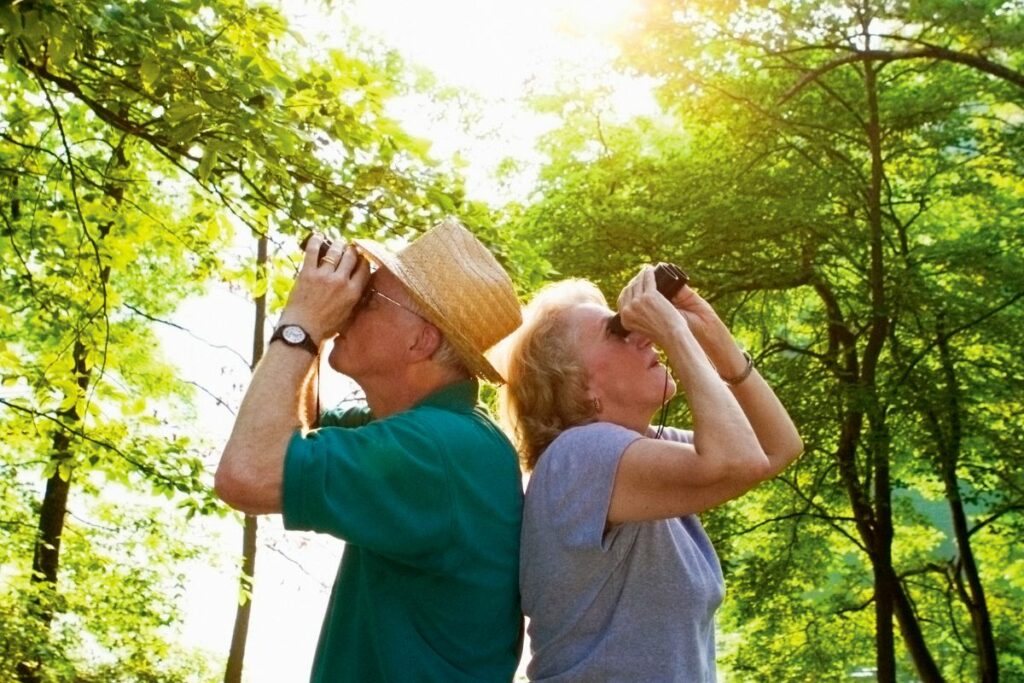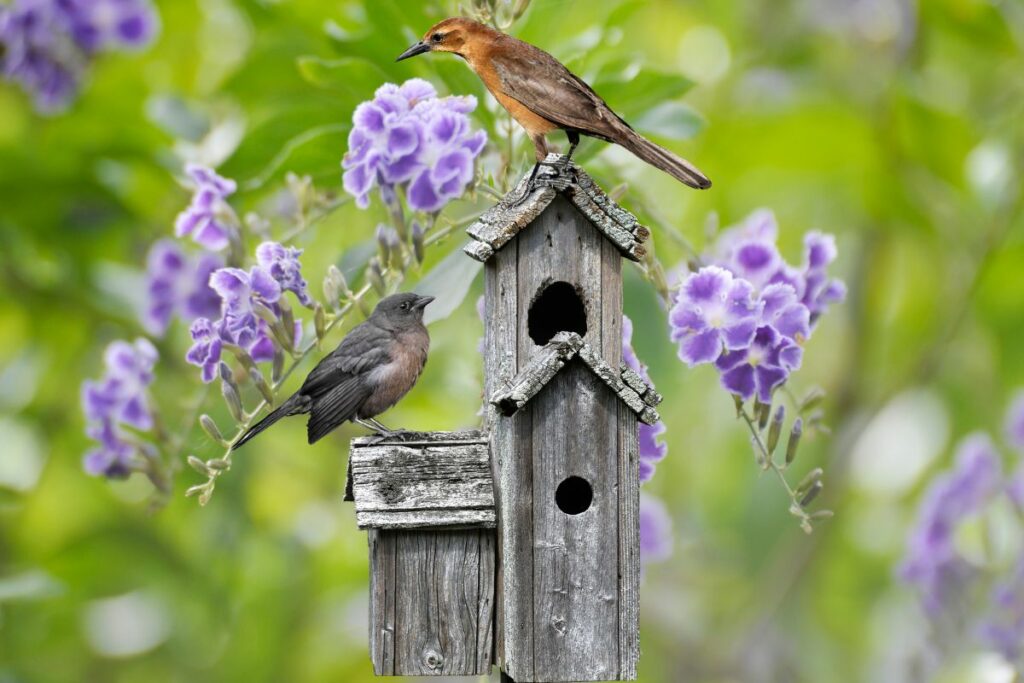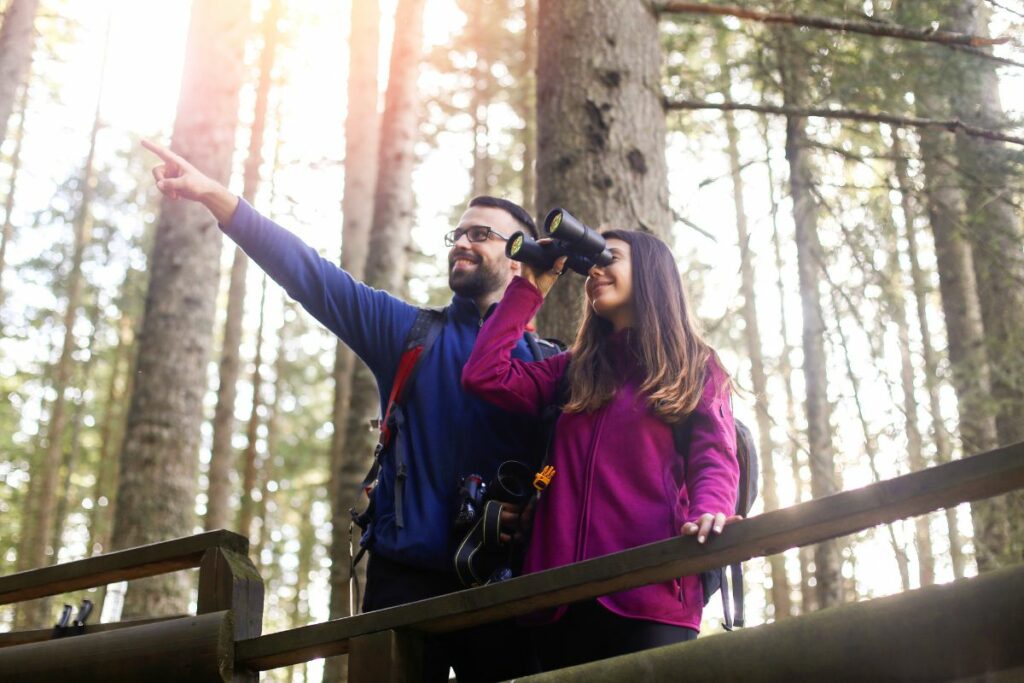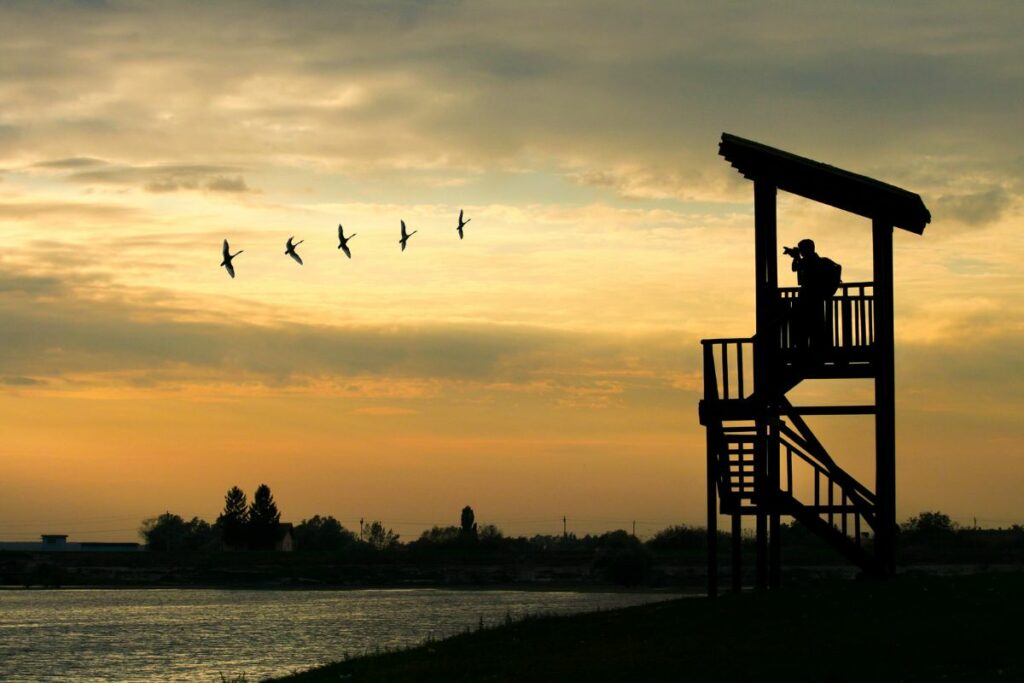As an Amazon Associate, we earn from qualifying purchases with no additional costs for you.
Bird watching is a healthy outdoor activity that people of any age can do. People may wonder, though, when the best time to bird watch is, especially since there are different seasons with varying conditions.
The best time to bird watch is in Spring when migrants return. Summer is when fledglings take their first flight, offering great sightings. Fall is great for observing large flocks in motion during migration, while Winter offers a chance to observe certain species in the absence of dense foliage.
This practical guide will help you discover when and where to observe birds in their natural habitats and will become your go-to resource for making every season count in your bird-watching adventure.
TIP: If you want to check out the best pair of binoculars for bird watching, we recommend a pair of waterproof and fog-proof 8 x 42 binoculars like the Celestron – Outland X 8×42 Binoculars (Amazon link).
When is the Best Time of Year for Bird Watching?
The best time of year to go out and look for birds may depend on where you live. For most of the United States, Spring and Summer are probably good seasons to choose from because you can find migrants in breeding plumage.
In other words, it is easier to identify some of the birds, which for beginner birders, is actually easier and less frustrating.
Spring migration is a good time to see neotropical migrants such as tanagers and orioles. Several warbler species can be spotted at this time. The males of the birds will be in breeding plumage, making it much easier to recognize and identify the individual species you see.
Another benefit of bird watching in Spring in the U.S. is that temperatures are not yet too hot in the southern states, meaning that conditions are more pleasant and comfortable for spending time outside bird watching.
TIP: Knowing how to spot the birds in your yard is key to enjoying visits from your winged friends as much as possible! The best sources are trusted books, I recommend using the following (Amazon links):
– National Geographic Field Guide to the Birds of North America
– National Audubon Society Birds of North America
Best Time for Bird Watching in Spring & Why
In the United States, the months of March to May are very good if you are bird-watching in Spring. This is because many migrating songbirds can be spotted at this time.
There are even birding festivals and activities that occur during Spring, where you can meet other bird watchers and learn about what birds are being seen at that time.
In April every year, for instance, the Houston Audubon Society holds a Spring festival at High Island in Texas. Bird watchers flock to the area from all over the country and even from overseas.
High Island contains patches of woodland that serve as one of the first stop-over spots for hungry songbird migrants.
This is where you can see thousands of birds, including tanagers, orioles, vireos, and warblers. If there is a storm, there can be a “fallout” where thousands of birds stop and land in the woods.
The day after a storm, I witnessed several Summer Tanagers, Scarlet Tanagers, and Baltimore Orioles appearing in the woods at High Island.
Best Time for Bird Watching in Summer & Why
Summer bird watching should be done very early in the morning if you live in the southern states of the U.S. This is because temperatures quickly rise, and by mid-morning, it can be unpleasant being outdoors, and as time goes on, it may even be dangerous to be outside for too long on the very hot days.
In summer, temperatures by mid-day and afternoon can soar and reach 100oF or more. Most birds will not be very active at this time, and the conditions are unhealthy for humans to be walking around in.
Early morning is also best for seeing most birds, as this is when species are most active. This is because birds, having just woken up, will be vocal, hungry, and searching for food.
Summer is also a good time to see migratory cuckoos both in North America and South Africa. In the United States, Yellow-billed Cuckoos will start arriving in Spring and should be evident by Summer. They have a distinctive call and can be seen in bushes and trees.
In South Africa, the African Emerald Cuckoos, Diederick Cuckoos, and Red-chested Cuckoos can be heard in October when they arrive from central Africa. These are also summer specialties that bird watchers can find in the savannahs and forests of southern Africa.
TIP: Choosing the right bird feeder is crucial when you want to attract birds on your backyard. There are a lot of options on how and where to place a bird feeder. Check out my picks on different bird feeders below (Amazon links):
– Free-standing Bird Feeder
– Hanging Bird Feeder
– Bird Feeder with Camera
Best Time for Bird Watching in Fall (Autumn) & Why
In the U.S., August through October are optimal for bird watching. This is when Fall migration occurs, and you can expect to see songbirds and other birds on their migration journey.
Do keep in mind, though, that Fall warblers are notoriously tricky to identify because they will not have their bright and distinctive coloring. This can make the identification of species very challenging.
Nonetheless, many people do go bird-watching during Fall and have a good time. Some bird watchers may enjoy the challenging aspect of trying to identify different species of warblers in the Fall.
The foliage also changes color at this time of year, making for a scenically beautiful time to be outdoors in the woods. Fall is also a time when temperatures may start cooling down, making being outdoors less unpleasant for some people.
Best Time for Bird Watching in Winter & Why
It may not seem like it, but Winter can be a good time to bird watch. This is because deciduous trees will have lost their leaves, meaning that it is easier to spot birds that would normally be hidden by thick foliage.
Anyone who has bird-watched in thick forest and bushveld understands how difficult and frustrating it can be when you can hear birds but cannot easily see them because of the thick foliage. It does help if you know the bird calls and have an idea of what bird you are actually looking for.
There are also certain types of birds that are only found in Winter in some parts of the U.S. For instance, sparrows and juncos are typical birds you will find in the south in Winter.
Waterfowl are also more common and abundant in Winter in most places. You can sometimes find thousands of geese and other waterfowl on a single lake.
Ducks and geese commonly move south to escape extreme cold at higher latitudes, and this is why Winter is the best time to see waterfowl in the mid-western and southern states.
TIP: Bird feeders and baths are great for attracting birds to your backyard. But what about bird houses? They will help you not only track but also keep them in your yard! Check out my picks on different bird houses below (Amazon links):
– Cedar Viewing House
– Wood Bird House with Pole
– Hanging Bird House
Best Time of Day for Bird Watching
The majority of bird watchers will agree that early morning or late afternoon are the best times of day to be out bird watching. Robins and thrushes, are often the first birds you can hear early in the morning. Some of these species are easy to see most times of the day, for example, the American Robin.
In South Africa, the Red-capped Robin-Chat is hardly ever seen or heard unless you arrive at a site at dawn. It is as the sun is coming up that you will hear these robin chats moving around and calling. You will often see them in Bushveld, hopping from branch to branch while calling.
Thermals and Birds
The rule of best birding in the early morning does not necessarily hold true for some raptors (birds of prey). This is because some of these birds rely on thermals for flight.
Thermals are pockets of air that rise as the air heats up. It may not be hot enough early in the morning to see larger raptors that usually soar on thermals.
In fact, seeing hawks and eagles is often better later in the morning than early morning in some parts of South Africa. Even early to mid-afternoon can be good.
In fact, I spotted a Martial Eagle once at 3 pm, on a very hot day, sitting on a fence post on the side of the road. The bird then took off flying (mainly soaring) across a valley.
Since this is the largest eagle in Africa one can assume that perhaps the hot temperatures and increased thermals made it easier for the bird to soar once temperatures had risen. It doesn’t mean you won’t see this bird and other raptors at other times of the day, though.
Vultures are another type of bird that uses thermals to fly. Using thermals is a good way for birds to save energy and not have to flap their wings all the time to stay aloft. You can, of course, also see birds of prey perched, and some, like sparrowhawks, may hunt more in the early morning and late afternoon.
There are a few rules or guidelines you should abide by as an ethical birder. These are listed below.
- Do not enter private lands without prior permission from landowners.
- Follow all the rules in refuges and reserves, including cleaning up any garbage from your campsite.
- Do not disturb birds on nests.
- Do not use apps and play songs to call up birds when they are hungry, tired, and breeding during spring and summer.
Is Evening a Good Time for Bird Watching?
Evening is only good for seeing and hearing specific types and species of birds. Evening is the best time to see nocturnal birds like nighthawks, nightjars, and owls.
You can sometimes see these birds during the day, but often, they are resting and are well-camouflaged. Nightjars will rest flat on the ground or on a tree branch where they will be dead still and so well-camouflaged you are unlikely to see them easily.
The nighthawks of North America are quite obvious when they start flying around at dusk, but it may be tricky to separate the Common Nighthawk from the Lesser Nighthawk.
The Common Nighthawk is the bird you are most likely to see. Nighthawks are also migrants that overwinter in South America and will only be seen in the night skies of the U.S. during Summer.
Nighthawks take advantage of the lights in developed areas. The lights attract insects at night, so you can often see nighthawks flying around near them. Baseball stadiums also attract many insects and nighthawks during night games because of the big lights.
Owls, such as the Barred Owl, can sometimes be seen and even heard during the day in woodland and forested areas. However, many owls in North America are not active at all during the day, and you will have to wait until nighttime to see if you can hear and see them.
Is Dusk a Good Time for Bird Watching?
Dusk is regarded by most birders to be a good time for bird watching. Some may consider this time of day to be as good as dawn for bird watching as birds are actively searching for food. There are some challenges with bird watching at dusk, though.
Dusk does limit the number of hours of daylight you have, and it can be difficult to know when the species are going to roost. You may find your trip is shorter than usual, and you see fewer birds because of the sun going down sooner than you expect.
Of course, the time of sunset will vary by season as well. In addition, some birds may have already left to roost if you arrive at a site too late in the day, which means you may lose out on seeing some species you were hoping to see.
Sunset is, however, a good time to see birds congregating at their roosts. Certain species, like starlings, mynahs, and swallows, may congregate and roost in the hundreds or thousands. It is quite a sight to see when these birds all start to converge on the same tree or patch of reeds.
Dusk Is Good For Viewing Secretive Marsh-Loving Birds
Another benefit of birding at dusk is you are more likely to see certain crepuscular species. Bitterns are birds that, although they are active during the day, are actually the most active at first light and at dusk. Bitterns are birds that occur in reed beds.
These birds are secretive and may be difficult to spot amongst the reeds where their plumage helps to camouflage them. It is easy to overlook these birds if they are standing still and not making any noise. Birds like the flufftails of Africa can also be seen and heard later in the day or even at night.
Conclusion
You can bird watch in every season in most places, but there are certain months in each season that are best. There are also certain times of day that are recommended to be most productive for bird watchers.
These times are early morning (at dawn) and late afternoon (dusk). Most birds are best seen at dawn and dusk, but some raptors that use thermals are more likely to be spotted when it is hotter, which is usually later in the morning or in the early afternoon.




